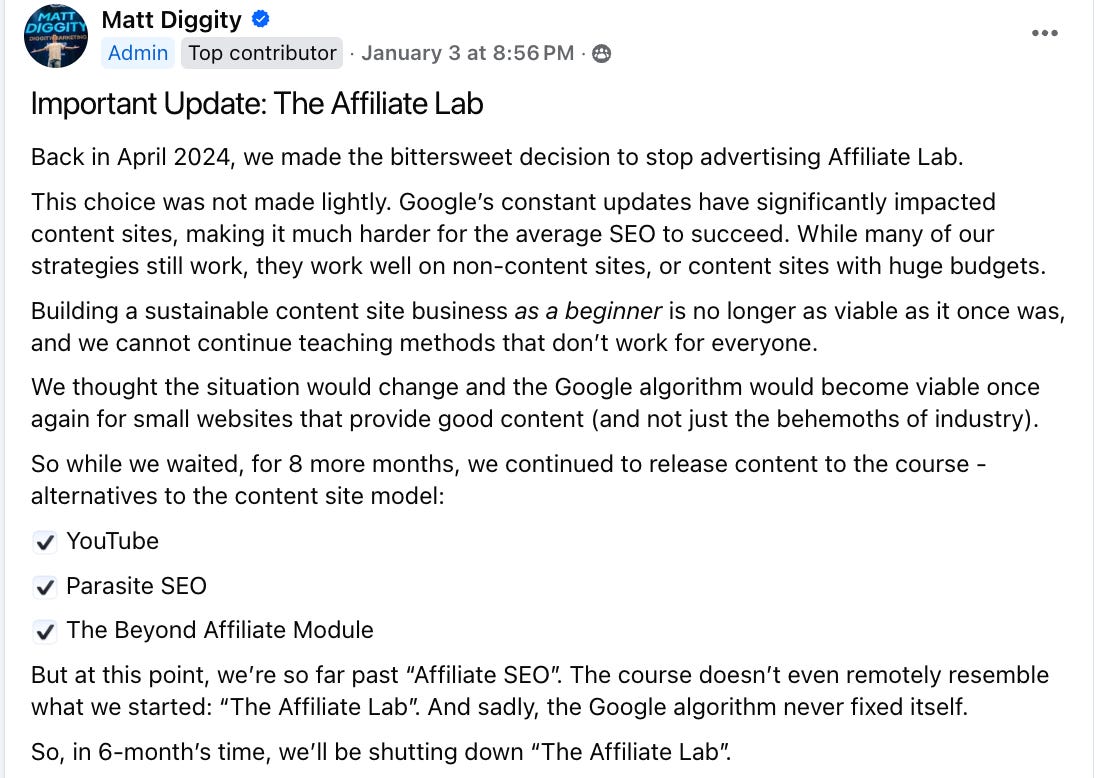AI’s Next Wave: 5 Predictions for B2B Startups, Growth, and Product Strategy
Trends shaping the future of B2B startups
By and large, I have been utterly disappointed with the predictions I have read on how AI will impact B2B startups. They are usually either too simplistic (e.g. “AI will lead to greater productivity”) or too much of a stretch (e.g. “AI will soon replace all jobs and human labor will no longer be necessary”). Through conversations with many folks in my network and doing a lot of thinking and analysis, I have come up with five bold predictions on how AI will fundamentally transform the B2B startup world.
While it is certainly hard to predict the future with accuracy, these predictions are built on a single, rock-solid premise. That premise is:
Generative AI makes content creation (text, video, code) substantially easier, cheaper, and faster.
Many of the predictions I make here are already happening, echoing the well-known science fiction writer William Gibson’s statement, “The future is already here – it’s just not evenly distributed.” I would appreciate any comments or feedback on my ideas, and I would love to spark a discussion on these topics. Anyone not interested in reading the full article can find the summary here.
#1 - Owning an audience grows massively in importance
While AI’s capabilities in text and video generation are extraordinary, I would argue that AI’s ability to generate high-quality code is even more impressive. For someone like myself, a tech lover who completed a coding boot camp 7 years ago but has not coded in 6 years, AI has enabled me to build and deploy fully fledged apps in 2 weeks that would take me 3+ months to complete without these tools. For savvy programmers who have coded daily for years on end, I can only imagine the speed at which they can now build and ship new products. This reduced barrier to entry is all but guaranteed to increase the number of startups and products out there.
With more and more startups fighting for recognition, it is inevitable that we will see more startup marketing and promotion online, many of which use AI-generated text and video. With so much content flooding Google, social media, and our inboxes, people will increasingly tune out the noise and become more distrustful of AI-generated slop. It’s a rapid race to the bottom, with startups using AI to generate code to rip off their competitors’ best product features and AI to analyze and then replicate their competitors’ best marketing tactics.
In such a world, trust becomes an increasingly rare commodity. When you are considering a new purchase, are you going to trust the robotic product pitches you get in your inbox 25 times per day, or are you going to trust the recommendations of your close friends and network? You are also likely to listen to niche-specific brands and influencers who have earned your trust. Most people think of influencers as people like Kim Kardashian or Logan Paul, people who are great at attracting attention and generating buzz. However, when I use the term, I am referring to individuals who have built up trust with an audience and can thus influence purchasing decisions (e.g. when I am considering AI products to try, I trust people like Kyle Poyar and Lenny Rachitsky).
In such a world, having a loyal and committed audience is essential. While having a strong brand is fantastic (e.g. Apple fans who camp out waiting for new Apple products), it’s far more powerful to build a thriving community where you have direct contact with your audience, can engage them in dialogue, and have a direct pulse on their needs and desires. Without owning an audience or community, you’ll be forced to pay those who have a strong audience or community to help promote your product on their behalf, which is not ideal.
#2 - Founders go audience-first
Traditionally, the trajectory of startup companies looks something like the following:
1). Generate a list of problems and ideas
2). Reach out to potential customers to get feedback
3). Build a lightweight, minimum viable product (MVP)
4). Go back to potential customers and determine if they would be willing to pay for the MVP
5). If demand is there, raise a seed round of funding
6). Build a fully-fledged product and start marketing it
7). If you successfully reach product-market fit, raise a series A round and scale
The biggest issue with this approach is that steps #2-#4 produce a relatively flimsy understanding of your market’s needs and desires, so making it successfully to step #7 is fairly unlikely. Only a small % of startups are able to successfully raise a seed round, and for those that do, the average age of a company is a little over 3 years. Once a company has raised a seed round, historically, 20%-24% of them raise a series A, although this dropped to 13% in 2022. Assuming an increase in startups and products seeking funding in the future, as I describe in point #1, I would expect the % of startups who successfully raise a seed and series A to continue to drop.
Greg Isenberg, a well-known entrepreneur and growth writer, suggests a novel approach:
John Rush, a SaaS entrepreneur who has launched over 20 companies, has a similar playbook:
Blake Anderson, a solo-preneur who built a 7-figure net worth by his mid-20s building viral apps, promotes a similar methodology:
If you understand your audience inside and out and are acutely aware of their problems and pain points, you won’t be like the 90%+ of startups that build products no one needs and never come close to product market fit. Furthermore, in a world of increased spam and decreased trust, the cost to acquire customers (CAC) with traditional marketing methods will only increase (as I describe in point #5). By starting audience-first, you not only get insights to inform your product, but you also have a built-in customer base ready to purchase your products and provide insights and feedback for new products.
#3 - Silos break down between growth, product, and sales
In point #1, I established that owning an audience will increase massively in importance, so much so that founders will go audience-first (point #2). However, one of the biggest blockers to truly understanding one’s audience and building a deep relationship with them is the current barriers that exist between growth, product, and sales. I expect these to break down in the future, paving the way for a far tighter connection to one’s audience.
Here is one way I envision things potentially playing out for B2B startups:
-Sales calls are automatically transcribed and analyzed using AI. Any recurring pain points or opportunities are identified and shared with the product team.
-Companies will prioritize education and onboarding, with well-structured training programs to increase activation speed and promote customer retention. Companies like Clay and Notion do a fantastic job with this. Issues or points of friction will be identified and shared with the product team.
-For customer support or product feature requests, customers are added to a Slack or Discord community where they communicate directly with the company’s engineers and product teams. This shifts the narrative of customer support from an annoyance that should be off-shored to a valuable source of insights and a chance to strengthen the bond with the core audience. If this sounds farfetched, Intuit does this and now solves customer support cases 36% faster and has boosted its NPS score by 12%.
-Social media takes on an increasingly important role. Data from social media as well as online reviews is mined by AI to identify customer pain points and identify opportunities, which are then shared with the product team.
-Marketing A/B tests or experiments, especially those that pertain to messaging, will be analyzed using AI and shared with the product team.
Instead of relying on customer interviews or market research to identify new product features to build, product managers will have fresh data directly from their target customers that will provide a key roadmap on what to build next.
#4 - Bootstrapping becomes more common
Despite over a decade of experience in the startup world, I’m still amazed at how much fanfare surrounds startups that raise massive amounts of funding. I have heard many founders brag about their “$20 million raise”, with no consideration for the equity that was exchanged or the massive expectations now placed on them to deliver a huge outcome fast. In other industries, such as music or publishing, creators take the opposite tact, bragging about how they are independent and own 100% of themselves. As 50 Cent said, “I don’t need a label, I can make it on my own / Put my city on my back, now they all in my zone.”
Historically, VC funding was essential for startups due to the high costs of building, deploying, and marketing a product. Programming was tricky to learn and even trickier to master, so it was necessary to hire from a select group of talented coders, who would need months or even years to build a fully fledged product. Before AWS launched in 2006, companies needed to set up physical servers in offices, which could easily run $10k+. Before the advent of paid online advertising, SEO, and social media, companies had to buy pricey media spots on TV, radio, print, or billboards.
Now, with the ability of AI to build and deploy products incredibly quickly and the ability to engage with and form close relationships with your audience on social media, there is less of a reason to raise bloated rounds of funding. Furthermore, smaller niches and audiences, which might be ripe for a $1-$5 million dollar business, suddenly open up, even though VCs would never invest in a market of that size. Considering all of these factors, I think it’s inevitable that in the long term, it becomes a badge of honor to build a big business without sacrificing equity or control along the way.
#5 - Paid ads, SEO, and cold email shift in major ways
As someone who has spent 10+ years mastering paid ads, SEO, and cold email, I find it a bitter pill to swallow that they have shifted substantially as a result of AI, and this change will only continue. Here are my predictions:
Paid Ads
For B2B startups, I expect paid ads to decrease in popularity as an acquisition channel. Some reasons I believe this:
-Since the Fed started to raise interest rates at the beginning of 2022, I have seen a decreased appetite amongst VCs for paid advertising. They are pushing more and more startups in their portfolios to SEO, product-led growth, social media marketing, and other channels.
-With a greater number of startups and products created and decreased trust (point #1), competition for paid ads will increase while conversion rates will drop.
-Paid ads have issues for both VC-backed and bootstrapped companies. For VC-backed companies, scaling paid ads to high-levels effectively requires a skilled and knowledgeable marketer or agency, which adds a lot of cost onto paid ad’s already thin margins. For bootstrapped companies, paid ads are tricky, even if they are profitable, because of cashflow concerns.
SEO:
For B2B startups, I predict SEO will increase in complexity and require a much deeper focus on systems and scalability. A few points on this:
-In 2023, Google declared that AI-generated content does not violate its guidelines as long as it is high-quality and authoritative.
-This has already produced some ripples in the SEO industry. Jake Ward, a UK entrepreneur, was able to steal 3.6 million views from a competitor by using AI to generate 1,800 articles. While there were some repercussions for this, it still was a massive win for Jake. Other companies like GrowthX are offering scaled AI content as a service, with options to get either 50,000 published words/month or 1,200 new pages per year.
-Matt Diggity, a seasoned SEO pro who has been in the space for 15+ years and created many SEO training programs, recently shutdown his “Affiliate Lab” course, since he believed things had shifted irreversibly.
-The days of publishing one article per week and zipping to the top of Google are over. The future SEO winners will be those who can reliably churn out hundreds of articles per month to game the algorithms while maintaining a sufficiently high level of authority with their content.
Cold Email
For B2B startups, I predict that in the short term, cold email will require far greater personalization to remain relevant, and in the long term, cold email will become much less effective as a channel. My thinking is as follows:
-The increased prevalence of AI web scrapers like Apify, as well as outreach automation platforms like HeyReach and La Growth Machine, has already led to email reply rates dropping to record lows in 2024. This was further confirmed by a close friend of mine, who is doing email outreach to purchase a company, and told me she had seen a noticeable drop in her outreach engagement over the past two years.
-While tools like Clay, which use AI to write highly personalized emails, can help to slow the trend, the increase in the number of startups and products and the corresponding marketing for them (point #1) will inevitably lead to viewer fatigue and tuning out promotional emails.
-I expect long-term, warm intros will become essential, or at least offering something compelling to catch the prospect’s attention using a tool like Sendoso.
Conclusion
The rise of AI is transforming the B2B startup landscape in profound and complex ways, reshaping how we think about audience building, product development, and go-to-market strategies. With generative AI making content creation cheaper, faster, and more accessible than ever, the barriers to entry are lower - but so too is the patience of audiences drowning in a sea of uniformity.
In this new era, the startups that thrive will be those that adapt to the shifting dynamics of trust, efficiency, and connection. Building and owning an audience will be paramount, forcing founders to rethink their approach from product-first to audience-first. Growth, product, and sales siloes will dissolve, making way for deeply integrated feedback loops that prioritize customer relationships and actionable insights. Bootstrapping will no longer be the exception but a celebrated norm, as lean, AI-powered startups carve out sustainable niches without sacrificing control. Meanwhile, traditional channels like paid ads, SEO, and cold email are evolving rapidly, demanding new strategies to cut through the noise.
If you liked this content, please click the <3 button on Substack so I know which content to double down on.
TLDR Summary
Generative AI is revolutionizing B2B startups by lowering barriers to entry for content creation, product development, and go-to-market strategies. However, these shifts come with challenges, forcing startups to adapt to a more crowded, competitive, and trust-driven landscape.
Key Predictions
1. Owning an Audience Becomes Crucial
Reason: The rise of AI-generated content creates a flood of similar marketing, reducing consumer trust in generic pitches.
What Changes:
Trust-based communities and niche influencers will dominate.
Startups will prioritize building direct relationships with their audience to gain a competitive edge.
Without an audience, startups must rely on influencers or paid platforms, increasing costs.
2. Founders Go Audience-First
Shift in Strategy:
Traditional product-first approaches are replaced with audience-first strategies.
Understanding audience pain points before building products ensures product-market fit.
Startups gain a built-in customer base and reduce reliance on traditional (and increasingly expensive) marketing channels.
3. Growth, Product, and Sales Silos Disappear
Integration of Functions:
AI enables deeper audience connections by analyzing data from sales calls, social media, and customer support.
Examples of AI-driven collaboration:
Sales: Automated transcription and analysis of calls for product insights.
Support: Community-based solutions via platforms like Slack or Discord.
Marketing: AI-powered A/B testing informs product roadmaps.
Outcome: Tighter feedback loops result in better product alignment with customer needs.
4. Bootstrapping Gains Popularity
AI Reduces Startup Costs:
AI accelerates product development and audience engagement, making massive funding less essential.
Bootstrapped startups can thrive in smaller, niche markets unattractive to VCs.
Founders maintain control and equity, celebrating independence over traditional funding models.
5. Marketing Channels Undergo a Major Shift
Paid Ads:
Rising competition and declining trust make paid ads less effective for B2B startups.
High costs and low margins hinder both VC-backed and bootstrapped companies.
SEO:
AI-generated content is reshaping SEO strategies.
Success will depend on scaling authoritative, high-quality content at unprecedented volumes.
Small-scale, manual SEO tactics will become obsolete.
Cold Email:
Personalization becomes essential as reply rates plummet due to widespread automation.
Long-term, warm intros and creative approaches will replace generic email blasts.
Conclusion
AI is transforming the B2B startup landscape by enabling faster and cheaper content creation and product development. To thrive, startups must shift from product-first to audience-first strategies, build integrated feedback loops across teams, and embrace bootstrapping as a viable path. As traditional marketing channels evolve, those that adapt to this trust-driven, efficiency-focused world will lead the next wave of innovation.


















Interesting thoughts.
I agree that founders should talk to their audience before building. There's this line everybody quotes in direct response marketing, that if you want to sell hamburgers, find a starving crowd. From my perspective it seems silly to start a business by doing anything other than talking to potential customers and asking them what they need.
One thought I've had about AI content. Right now everyone is just sort of assuming that AI can write really good content. Most people will probably do the conventional wisdom thing and generate articles with AI. I think you can gain a lot of territory by zagging and writing really good human content that people actually want to read.
Good writing comes from having original ideas. Whereas AI just spits out a summary of what everybody else is saying. (For example, AI could not have possibly written this newsletter.)
Maybe AI content will help you get to the top of Google, and maybe it can help you build credibility with beginners. But I think that if you want to attract sophisticated audiences, you have to keep writing by hand. Sophisticated audiences already know everything that an AI can spit out.
(Maybe I am just trying to convince myself of that because I write for a living? Maybe the writing is already on the wall? I have no idea.)
Curious to see what VCs will do with their money if many founders try to go the bootstrapping route